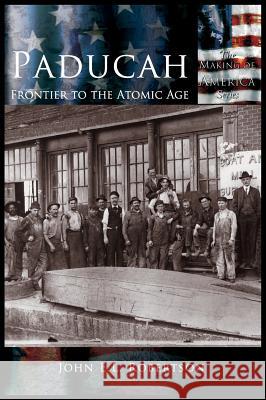Paducah: Frontier to the Atomic Age » książka
Paducah: Frontier to the Atomic Age
ISBN-13: 9781589730984 / Angielski / Twarda / 2002 / 162 str.
One of the last frontier towns east of the Mississippi, Paducah took center stage in the drama of an expanding United States despite a late start and a penchant for independence and self reliance. The Kentucky river city played no small part in the rise of river commerce and its successor, the railroads. From river packets to enriched uranium, its history is marked by victory over disastrous floods and a headlong rush toward a future embracing new technology.Paducah: Frontier to the Atomic Age tells the story of a community torn apart from the start between Chickasaw and American claims, then Confederate and Union invasions. Exploring the expanding city streets and the ever-busy waterfront, readers will meet natives Quintus Quincy Quigley, chronicler of events on the eve of the Civil War; the "Dean," Dr. Robert Gordon Matheson, who revolutionized two-year colleges; and Mrs. Houston "Dolly" McNutt, among the first female mayors in Kentucky.This unique volume also recounts the story of the city's central role in nineteenth-century history, thanks to its strategic location at the mouth of the Tennessee River on the Ohio. At that time, the Civil War struggle for control of border states tested Paducah's loyalty even while the rest of Kentucky fought to remain neutral, and Reconstruction brought new challenges in race relations to a region deeply divided by the ghosts of slavery. In the twentieth century, the city developed tremendously with the advent of new industry and was the adopted home of President Truman's pioneering Vice President Alben Barkley, among the most effective and groundbreaking statesmen to fill that office.
One of the last frontier towns east of the Mississippi, Paducah took center stage in the drama of an expanding United States despite a late start and a penchant for independence and self reliance. The Kentucky river city played no small part in the rise of river commerce and its successor, the railroads. From river packets to enriched uranium, its history is marked by victory over disastrous floods and a headlong rush toward a future embracing new technology.
Paducah: Frontier to the Atomic Age tells the story of a community torn apart from the start between Chickasaw and American claims, then Confederate and Union invasions. Exploring the expanding city streets and the ever-busy waterfront, readers will meet natives Quintus Quincy Quigley, chronicler of events on the eve of the Civil War; the "Dean," Dr. Robert Gordon Matheson, who revolutionized two-year colleges; and Mrs. Houston "Dolly" McNutt, among the first female mayors in Kentucky.
This unique volume also recounts the story of the citys central role in nineteenth-century history, thanks to its strategic location at the mouth of the Tennessee River on the Ohio. At that time, the Civil War struggle for control of border states tested Paducahs loyalty even while the rest of Kentucky fought to remain neutral, and Reconstruction brought new challenges in race relations to a region deeply divided by the ghosts of slavery. In the twentieth century, the city developed tremendously with the advent of new industry and was the adopted home of President Trumans pioneering Vice President Alben Barkley, among the most effective and groundbreaking statesmen to fill that office.











